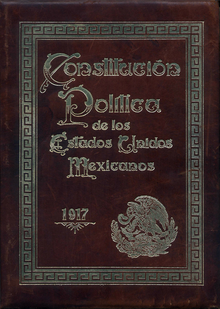
Back دستور المكسيك Arabic Constitución Política de los Estaos Xuníos Mexicanos AST Конституция на Мексико Bulgarian Constitució Política dels Estats Units Mexicans Catalan Politische Verfassung der Vereinigten Mexikanischen Staaten German Constitución Política de los Estados Unidos Mexicanos Spanish Constitution mexicaine de 1917 French Մեքսիկայի սահմանադրություն Armenian Konstitusi Meksiko ID Costituzione del Messico Italian
| Political Constitution of the United Mexican States | |
|---|---|
 Cover of the original copy of the Constitution | |
| Overview | |
| Jurisdiction | Mexico |
| Ratified | 5 February 1917 |
| System | Constitutional presidential republic |
| Government structure | |
| Branches | 3 |
| Chambers | Bicameral (Senate and Chamber of Deputies) |
| Executive | President |
| Electoral college | Only in cases of permanent or absolute absence of the President, the General Congress elects an acting president when necessary; Deputies validated presidential elections until 1993. |
| First legislature | 15 April 1917 |
| First executive | 1 May 1917 |
| Location | Lecumberri Palace |
| Author(s) | Constituent Congress of 1917 |
| Supersedes | Constitution of 1857 |
 |
|---|
|
|
The current Constitution of Mexico, formally the Political Constitution of the United Mexican States (Spanish: Constitución Política de los Estados Unidos Mexicanos), was drafted in Santiago de Querétaro, in the State of Querétaro, Mexico, by a constituent convention during the Mexican Revolution. It was approved by the Constituent Congress on 5 February 1917, and was later amended several times. It is the successor to the Constitution of 1857, and earlier Mexican constitutions. "The Constitution of 1917 is the legal triumph of the Mexican Revolution. To some it is the revolution."[1]
The current Constitution of 1917 is the first such document in the world to set out social rights, serving as a model for the Weimar Constitution of 1919 and the Russian Soviet Federative Socialist Republic Constitution of 1918.[2][3][4][5] Some of the most important provisions are Articles 3, 27, and 123; adopted in response to the armed insurrection of popular classes during the Mexican Revolution, these articles display profound changes in Mexican politics that helped frame the political and social backdrop for Mexico in the twentieth century.[6] Article 3 established the basis for free, mandatory, and secular education;[7][8] Article 27 laid the foundation for land reform in Mexico;[8] and Article 123 was designed to empower the labor sector, which had emerged in the late nineteenth century and which supported the winning faction of the Mexican Revolution.[8]
Articles 3, 5, 24, 27, and 130 seriously restricted the Roman Catholic Church in Mexico,[9] and attempts to enforce the articles strictly by President Plutarco Calles (1924–1928) in 1926 led to the violent conflict known as the Cristero War.[9]
In 1992, under the administration of Carlos Salinas de Gortari, there were significant revisions of the constitution, modifying Article 27 to strengthen private property rights, allow privatization of ejidos and end redistribution of land, and the articles restricting the Roman Catholic Church in Mexico were largely repealed.[10][11][12][13][14]
Constitution Day (Día de la Constitución) is one of Mexico's annual Fiestas Patrias (public holidays), commemorating the promulgation of the Constitution on 5 February 1917. The holiday is held on the first Monday of February.[15]
- ^ Niemeyer, E.V. Revolution at QuerétaroÉ: The Mexican Constitutional Convention of 1916–1917. Austin: University of Texas Press 1974, 233.
- ^ Centeno, Ramón I. (1 February 2018). "Zapata reactivado: una visión žižekiana del Centenario de la Constitución". Mexican Studies/Estudios Mexicanos. 34 (1): 36–62. doi:10.1525/msem.2018.34.1.36. ISSN 0742-9797. S2CID 149383391. Archived from the original on 13 April 2018.
- ^ Catholic University of America. Dept. of Canon Law (1942). The jurist, Volume 2. School of Canon Law, the Catholic University of America. p. 172. Archived from the original on 10 May 2018.
- ^ a b c Héctor Aguilar Camín; Lorenzo Meyer (1993). In the shadow of the Mexican revolution: contemporary Mexican history, 1910–1989. University of Texas Press. p. 63. ISBN 0-292-70451-8. Archived from the original on 10 May 2018.
- ^ a b Soberanes Fernández, José Luis, Mexico and the 1981 United Nations Declaration on the Elimination of All Forms of Intolerance and of Discrimination Based on Religion or Belief Archived 19 October 2012 at the Wayback Machine, pp. 437–438 nn. 7–8, BYU Law Review, June 2002
- ^ Roberto Blancarte (1993). "Recent Changes in Church-State Relations in Mexico: An Historical Approach". Journal of Church & State. 35 (4).
- ^ Jorge A. Vargas (1998). "Freedom of Religion and Public Worship in Mexico: A Legal Commentary on the 1992 Federal Act on Religious Matters". BYU Law Review (2): 421–481. Archived from the original on 18 February 2015.
- ^ Jorge A. Vargas (1996). "Mexico's Legal Revolution: An Appraisal of Its Recent Constitutional Changes, 1988–1995". Georgia Journal of International and Comparative Law. 25: 497–559. Archived from the original on 4 March 2016.
- ^ Ricardo Hernández-Forcada (2002). "The Effect of International Treaties on Religious Freedom in Mexico". BYU L. Rev. 2002 (2). Archived from the original on 7 January 2016.
- ^ Victor Gabriel Muro, "Catholic Church: Mexico" in Encyclopedia of Mexico vol. 1, p. 222. Chicago: Fitzroy Dearborn 1997.
- ^ "Mexico will Celebrate Constitution Day on February 6th". www.banderasnews.com. 3 February 2023. Retrieved 5 February 2023.